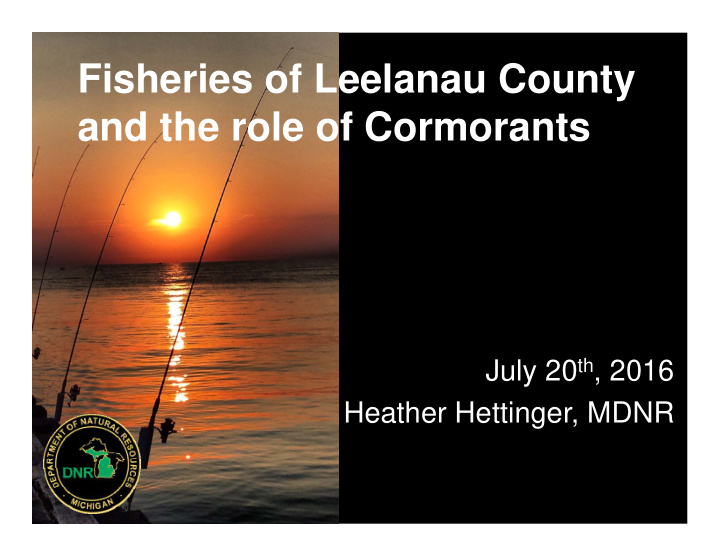



Fisheries of Leelanau County and the role of Cormorants July 20 th , 2016 Heather Hettinger, MDNR
Cormorants • Federally protected migratory bird – Why? Their numbers were once in decline- the use of DDT has been blamed for their all-time low numbers in the late 1960’s. However the abundance of alewives in the Great Lakes Basin and the discontinuation of DDT has resulted in a population boom for this region. • The U.S. Fish and Wildlife Service retains oversight and the control measures are not extended to the general public (no hunting season). • Wildlife Services, USDA – DNR Fisheries Division plays a supporting role (coordination, reporting, volunteers) • Diet comprised of fish, amphibians, crustaceans • The goal of control is to protect fisheries resources of the Great Lakes, as well as other public resources like colonial water bird nesting sites and protecting old growth cedars.
Control Types • Strategies for managing cormorants include harassment at spring spawning grounds and DNR fish stocking sites, and egg oiling and adult removal (culling)at nesting colonies. • From 2007-2014, the peak nesting of cormorants has been reduced 60%.
2015 Control Sites • Les Cheneaux Islands • Bays De Noc • Beaver Islands • Ludington • Thunder Bay • Saginaw Bay • Harassment at inland lakes and Great Lakes stocking sites- GTASFA and BIWC
Behavior • Are cormorants shifting inland? – Yes – Lack of Great Lakes forage species – What are we doing about it? • It is important to control cormorants not just because of fisheries reasons, but also to benefit nesting shore birds • Showing up inland in Leelanau County… – Glen Lake – Lime Lake
2016? • In late May 2016 the Courts vacated the Order that provided much of the authority to manage cormorants. – Aquaculture Depredation Order – Courts decided that the reasons listed by the FWS were not legititmate – “forecasted harms are imprecise or speculative” • FWS is currently updating the Environmental Assessment in order to challenge this ruling. • The only activities still permitted are the non-lethal hazing of feeding cormorants
Cormorant Questions?
North Lake Leelanau • Surveyed in 2016 – Netting component May 9-13 – Seining and electrofishing component July 5 • Targeted lake trout work to come this fall… • Full survey results will be available in the spring/summer of 2017.
South Lake Leelanau • Surveyed in 2015 • 16,966 individual fish were captured – 13,369 Mimic Shiners – 1,142 Rock Bass – 270 Longnose Gar – 174 Walleye – 78 Smallmouth Bass • Notable species; Longear Sunfish, Pumpkinseed Sunfish, Cisco, Brown Trout • Full survey results will be presented at the August Lake Leelanau Assoc. meeting
Cedar Lake • Surveyed in 2014 • 2,480 individual fish captured – 1,240 Mimic Shiners – 384 Rock bass – 214 Largemouth (3-18”) – 105 Pumpkinseeds (1-9”) – 37 Northern Pike (13-28”) – 22 Smallmouth (1-22”) • Notable species; Mottled Sculpin & Brown Trout • Finished survey results are currently being published as a Status of the Fishery Report written by Tara Novak; being edited now, should be approved by fall.
Little Traverse Lake • Surveyed in 2013 • 861 individual fish collected – 261 Rock Bass – 113 Pumpkinseeds – 107 Common Shiners – 54 Smallmouth Bass (1-20”) – 49 Yellow Perch (6-12”) • Notable species; Longear Sunfish, Banded Killifish, Northern Pike up to 30”
Lime Lake • Surveyed in 2010 (to assess trout stocking) • 1,912 individual fish captured – 1,203 Rock Bass – 103 White Suckers – 71 Smallmouth Bass (3-20”) – 28 Brown Trout (6-14”) (2 year classes) • Notable species; Alewife, Longear Sunfish • Full survey results are available online in the Status of the Fishery Report # 2001-117
Glen Lake (Little Glen, Big Fisher, Little Fisher, Tucker) • Surveyed in 2009 • 1,072 individual fish collected – 305 Cisco (7-12”) – 303 Yellow Perch (3-14”) – 17 Smallmouth Bass – 15 Lake Trout • Notable species; Coho salmon, Northern Pike • Species of concern; Rainbow Trout? • Full survey results are available online in the Status of the Fishery Report # 2010-100
What else do we do in Leelanau? • Stream surveys – Shalda Creek (2014) – Lime Creek (2014) – Hatlem’s Creek (2016) – Northport Creek (2015 & 2016 planned) – Mebert Creek (2010) • Juvenile Whitefish and Cisco assessments – Leland – Good Harbor Bay – Sleeping Bear Point
Recommend
More recommend